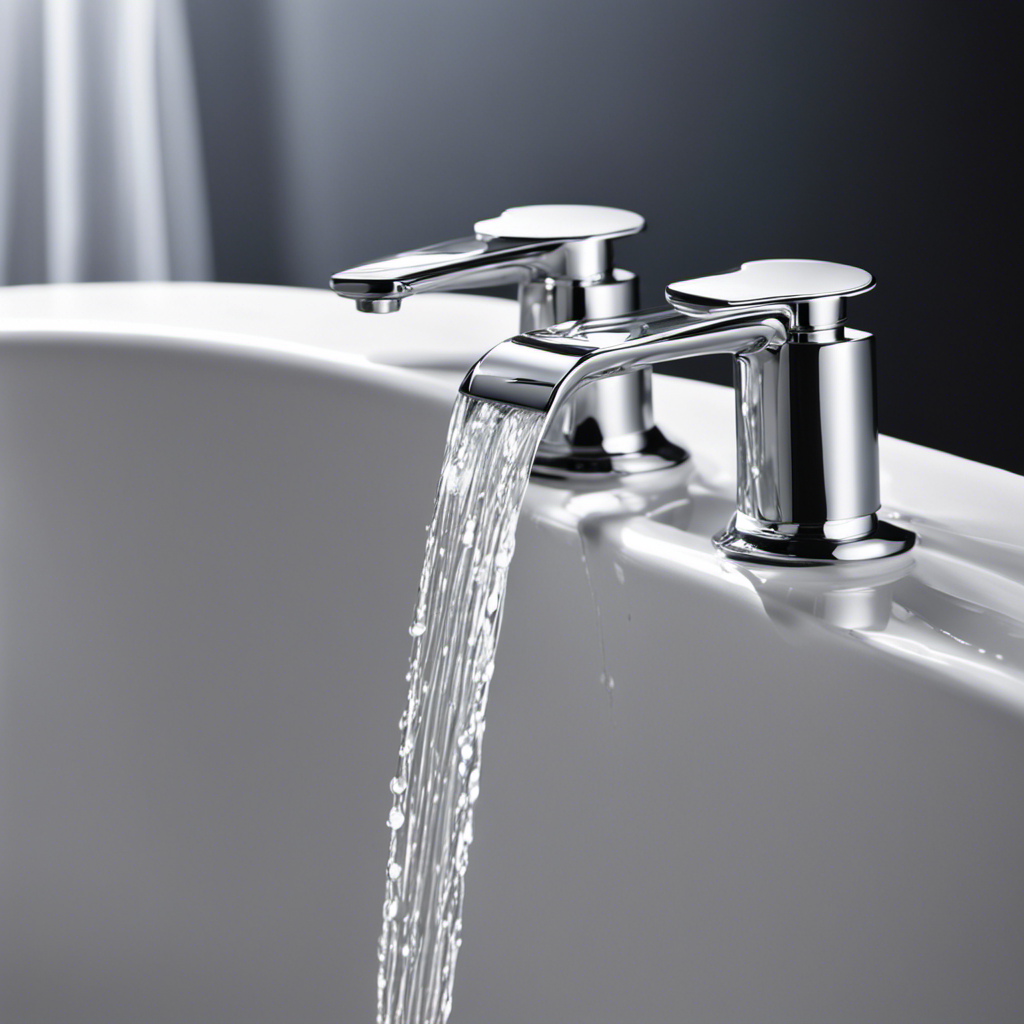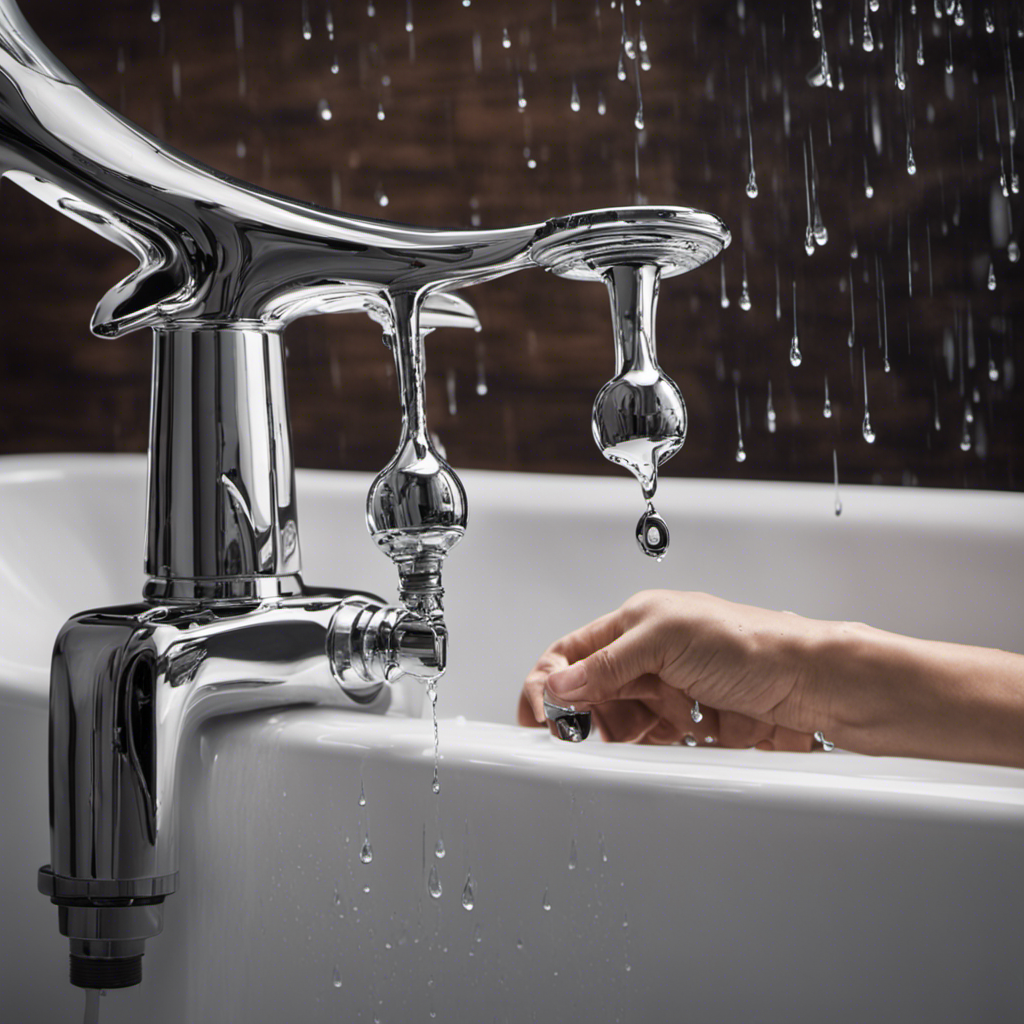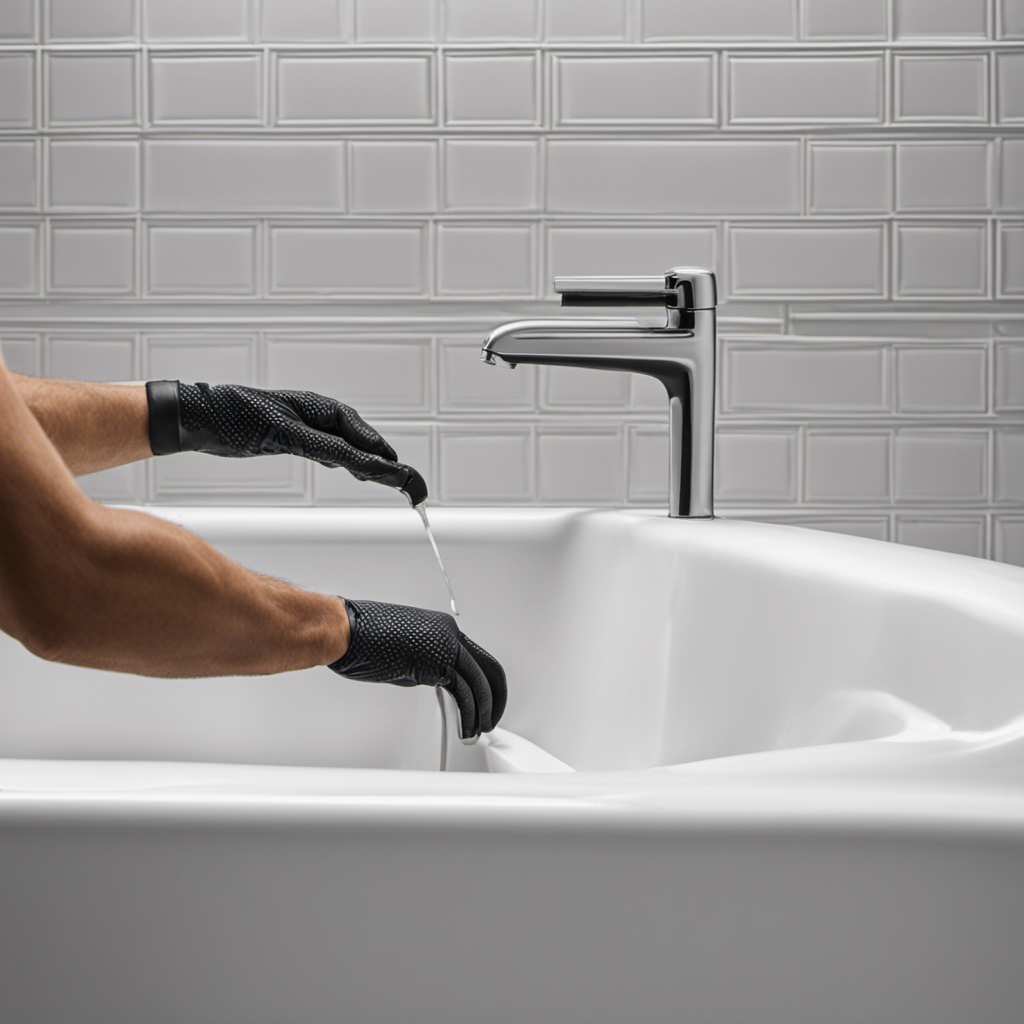Hey there! Ever wondered how to keep your bathtub faucet sparkling clean? Well, I’ve got you covered.
In this article, I’ll show you the step-by-step process to effectively clean your bathtub faucet, so you can enjoy a hygienic and well-maintained bathroom.
We’ll dive into the importance of regular cleaning, gather the necessary tools, and tackle those pesky mineral deposits.
So, let’s get started and bring that faucet back to its shining glory!
Key Takeaways
- Regular cleaning and prevention of build-up is important to maintain the performance of a bathtub faucet.
- Natural cleaning solutions, such as vinegar and baking soda, are effective and eco-friendly options for cleaning faucets.
- Proper maintenance and troubleshooting techniques can help identify and resolve issues with water flow and functionality.
- Taking proactive measures, such as using natural cleaning solutions and wiping down the faucet regularly, can prevent future build-up and corrosion.
Understanding the Importance of Cleaning Your Bathtub Faucet
Understanding the importance of cleaning your bathtub faucet is crucial to maintaining its functionality and hygiene. Regular maintenance is essential to prevent the build-up of mineral deposits, soap scum, and bacteria, which can hinder the faucet’s performance and compromise its cleanliness.
Neglecting proper cleaning can lead to clogged aerators, reduced water flow, and even the growth of harmful microbes. Using natural cleaning solutions offers several benefits. They are gentle on the faucet’s finish, preventing any damage or discoloration. Additionally, natural solutions are eco-friendly and safer for your health, as they do not contain harsh chemicals.
Vinegar and baking soda, for example, can effectively remove stains and disinfect the faucet without causing any harm.
Gathering the Necessary Tools and Materials
To get started, you’ll need a few tools and materials for the task at hand. Here is a list of the necessary items:
-
Cleaning tools:
-
Soft-bristle toothbrush: This will help you scrub away any dirt or grime that has built up in hard-to-reach areas.
-
Microfiber cloth: Perfect for wiping down the faucet and removing any residue or water spots.
-
Mild cleaning solution: Choose a gentle cleaner that won’t damage the faucet’s finish.
-
Necessary materials:
-
Warm water: This will be used to wet the toothbrush and cloth before cleaning.
-
White vinegar: A natural and effective cleaning agent that will help dissolve mineral deposits.
-
Q-tips: These will come in handy for cleaning small crevices and tight spaces around the faucet.
With these tools and materials, you’ll be well-equipped to tackle the task of cleaning your bathtub faucet.
Preparing Your Faucet for Cleaning
Before you begin, make sure you have all the necessary tools and materials ready for preparing your faucet for cleaning.
The first step in preparing your faucet for cleaning is to turn off the water supply. This can usually be done by locating the shut-off valves underneath the sink.
Next, you’ll want to remove any decorative attachments or handles from the faucet. This will make it easier to clean and prevent any damage to these parts.
Once the attachments are removed, use a soft cloth or sponge to wipe down the faucet, removing any surface dirt or grime. Be sure to pay attention to any crevices or hard-to-reach areas.
Removing Mineral Deposits and Build-up
Once you’ve gathered your materials, start by applying a vinegar solution to the mineral deposits on your faucet. This natural cleaning solution is effective in removing stubborn build-up without causing any damage to the faucet.
Here’s a step-by-step guide to help you through the process:
- Pour a mixture of equal parts white vinegar and water into a small bowl or container.
- Dip a clean cloth or sponge into the vinegar solution.
- Gently scrub the mineral deposits on the faucet, ensuring you cover all the affected areas.
Cleaning the Faucet Handle and Spout
When it comes to cleaning the faucet handle and spout, there are two key points to consider: removing stubborn grime and preventing future buildup.
Stubborn grime can be a real challenge to tackle, but with the right tools and techniques, it can be effectively removed.
Additionally, taking preventive measures can help keep your faucet handle and spout cleaner for longer periods of time, saving you the hassle of frequent cleaning.
Removing Stubborn Grime
To get rid of stubborn grime on your bathtub faucet, start by applying a mixture of vinegar and baking soda. Here’s how to do it:
- First, combine equal parts vinegar and baking soda in a small bowl.
- Next, use a cloth or sponge to apply the mixture to the faucet.
- Gently scrub the faucet, focusing on areas with tough stains.
- Let the mixture sit on the faucet for about 10 minutes to allow it to break down the grime.
After 10 minutes, use a scrub brush or an old toothbrush to scrub away the grime. Rinse the faucet thoroughly with water to remove any residue. Finally, dry the faucet with a clean cloth to prevent water spots.
Using natural cleaning solutions like vinegar and baking soda is not only effective in removing tough stains, but it is also safe for you and the environment.
Preventing Future Buildup
Now that we have successfully removed the stubborn grime from our bathtub faucet, let’s talk about preventing future buildup. It’s essential to take proactive measures to protect our faucets and keep them clean for longer periods. One effective way to do this is by using natural cleaning solutions that are gentle on the fixtures and won’t cause any damage. Here is a table outlining some natural cleaning solutions and their benefits:
| Natural Cleaning Solution | Benefits |
|---|---|
| Vinegar | Removes mineral deposits |
| Baking soda | Eliminates stains and odors |
| Lemon juice | Dissolves soap scum |
| Hydrogen peroxide | Kills bacteria and germs |
Maintaining a Clean and Functional Bathtub Faucet
Maintaining a clean and functional bathtub faucet is essential for a smooth and hassle-free bathing experience. It involves preventing mineral buildup, which can hinder water flow and affect the overall performance of the faucet.
Additionally, cleaning hard-to-reach areas is crucial to ensure that no dirt or grime accumulates, which can lead to clogged or restricted water flow.
Preventing Mineral Buildup
Regularly cleaning your bathtub faucet with vinegar can help prevent mineral buildup. The acidic properties in vinegar break down and dissolve the minerals, keeping your faucet clean and free from corrosion.
Here are some steps to effectively prevent mineral buildup using natural cleaning methods:
- Start by mixing equal parts of white vinegar and water in a spray bottle.
- Spray the solution onto the faucet, making sure to cover all the areas affected by mineral buildup.
- Let the vinegar solution sit for a few minutes to allow it to penetrate and dissolve the minerals.
- Use a soft brush or toothbrush to gently scrub the faucet, focusing on the areas with buildup.
- Rinse the faucet thoroughly with warm water to remove any remaining vinegar solution and minerals.
Cleaning Hard-To-Reach Areas
To effectively tackle hard-to-reach areas, try using a small brush or toothbrush along with the vinegar solution.
These areas can be a breeding ground for rust stains and can also promote mold growth if not properly cleaned.
Start by mixing equal parts of vinegar and water in a spray bottle.
Spray the solution onto the brush and scrub the hard-to-reach areas, such as the corners and crevices of the bathtub faucet.
Use firm but gentle strokes to remove any dirt, grime, or mineral buildup.
Rinse the faucet thoroughly with water to remove any remaining vinegar solution.
Ensuring Proper Water Flow
If water flow becomes restricted, it may be necessary to check the aerator for debris or mineral buildup. To ensure proper water pressure and troubleshoot common faucet issues, follow these steps:
- Start by turning off the water supply to the faucet.
- Unscrew the aerator from the end of the faucet spout using pliers or your hands.
Inspect the aerator for any visible debris or mineral buildup. If you see debris, rinse it off with water or use a small brush to gently scrub it away. For mineral buildup, soak the aerator in a vinegar solution for about 30 minutes. Use a toothbrush to scrub away any remaining mineral deposits.
Rinse the aerator thoroughly and screw it back onto the faucet spout. Turn on the water supply and check if the water flow has improved.
Conclusion
In conclusion, taking the time to clean your bathtub faucet is like giving it a refreshing spa treatment. By removing mineral deposits and build-up, you ensure that your faucet functions smoothly and efficiently.
With just a few simple steps, you can maintain a clean and sparkling faucet handle and spout. So grab your cleaning tools and get ready to give your faucet the TLC it deserves.
Trust me, your bathtub faucet will thank you for it!










